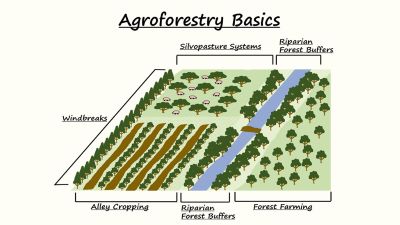Context
Agroforestry, the practice of integrating trees with crops and livestock, has emerged as a sustainable land-use strategy with the potential to enhance farmer livelihoods and environmental resilience. In India, where agriculture has traditionally been diversified, agroforestry offers a promising alternative to monocropping, which has dominated farming practices since the Green Revolution. However, despite its potential benefits, the adoption of agroforestry among small-scale farmers has been limited due to various challenges, including water scarcity and lack of access to finance.
Water Availability: A Recurrent Challenge
One of the primary challenges hindering the adoption of agroforestry among smallholders is water availability. The National Agroforestry Policy of 2014 recognized this issue, yet small-scale farmers continue to struggle with securing sufficient water resources for tree cultivation, especially during the critical sapling stage. In water-constrained regions, where competition for water between trees and crops is high, farmers face additional hurdles in sustaining agroforestry systems.
To address the water scarcity challenge, it is essential to identify tree species that do not compete with crops for water. Tools like 'Jaltol,' developed by WELL Labs, help assess water requirements of different tree species and their compatibility with existing crops. For instance, mango plantations in certain regions of Karnataka have been found to complement rather than compete with kharif crops, offering insights into suitable agroforestry combinations. By selecting appropriate tree-crop combinations based on water availability, farmers can mitigate water-related risks and enhance the sustainability of agroforestry systems.
Selecting Suitable Species: Balancing Productivity and Sustainability
Choosing the right tree species is crucial for the success of agroforestry initiatives. While fast-growing and herbivore-resistant species may seem attractive to farmers, prioritizing native species that support soil health and biodiversity is essential for long-term sustainability. Non-native species like casuarina and eucalyptus, although fast-growing and low-maintenance, can have detrimental effects on soil health and ecosystem integrity, particularly when grown as monocultures.
Tools such as 'Diversity for Restoration' aid in selecting climate-resilient native species that align with restoration objectives while considering regional biophysical variabilities. By promoting the cultivation of native species that enhance ecosystem services and support livelihoods, agroforestry initiatives can contribute to biodiversity conservation and mitigate land degradation.
Financial Barriers: Overcoming Transition Costs
In addition to ecological challenges, small-scale farmers face financial barriers in transitioning to agroforestry. The costs associated with establishing tree plantations, accessing water resources, and complying with certification schemes pose significant challenges for resource-constrained farmers. Existing government policies and schemes often fail to account for the needs of smallholders, further exacerbating financial barriers to agroforestry adoption.
Payment for ecosystem services (PES) and ecosystem credits emerge as potential incentive mechanisms to overcome financial barriers and promote agroforestry among small-scale farmers. By compensating farmers for the environmental services provided by trees, such as pollination and soil conservation, PES schemes incentivize sustainable land-use practices while generating additional income for farmers. However, the successful implementation of PES schemes requires careful consideration of local biophysical conditions and stakeholder engagement to ensure equitable distribution of benefits.
Strategies to Advance Agroforestry Practices
To propel the adoption of agroforestry, a multifaceted approach is imperative, encompassing institutional support, financial incentives, regulatory reforms, and community engagement.
1. Institutional Strengthening and Advocacy
● Elevate the visibility and significance of agroforestry across institutions, highlighting its role in farm-forestry integration, environmental conservation, and sustainable development.
2. Inclusive Financial Assistance
● Extend financial aid to all small landholders, transcending caste and tribe boundaries, to foster widespread participation in agroforestry initiatives.
3. Carbon Trading Opportunities
● Develop protocols enabling smallholders to generate revenue through carbon trading, aligning environmental stewardship with economic incentives.
4. Tailored Financial Products
● Design institutional credit schemes featuring extended funding cycles, interest moratoriums, and agroforestry-suited insurance products, facilitating sustainable investment in tree-based farming.
5. Private Sector Engagement
● Encourage private sector involvement in agroforestry, leveraging both commercial interests and corporate social responsibility initiatives to bolster sustainable agricultural practices.
6. Empowering Farmer Collectives
● Promote the formation of farmer collectives such as cooperatives and FPOs to enhance capacity building and facilitate the expansion of tree-based farming and associated value chains.
7. Ambitious Targets
● Set ambitious goals to cover at least 10% of farmland with trees, underlining the commitment to integrating agroforestry into mainstream agricultural practices.
8. Regulatory Reforms
● Amend restrictive legislation and streamline regulatory frameworks governing forestry and agriculture to create an enabling environment for agroforestry expansion.
9. Mainstreaming Agroforestry in Policy
● Integrate agroforestry into all relevant land use and natural resource management policies, urging government investment in agroforestry infrastructure and sustainable enterprises.
10. Locally-Tailored Technological Solutions
● Foster collaboration between scientists, researchers, and local communities to develop location-specific tree-based technologies that complement existing agricultural systems, address gender disparities, and promote sustainable livelihoods.
By embracing these comprehensive strategies and fostering collaboration among stakeholders, we can unlock the full potential of agroforestry to mitigate environmental degradation and enhance agricultural sustainability.
Conclusion
Agroforestry holds immense potential to transform India's agricultural landscape by promoting sustainable land-use practices and enhancing farmer livelihoods. However, to realize this potential, concerted efforts are needed to address the challenges hindering agroforestry adoption among small-scale farmers. By prioritizing water-efficient tree species, promoting native biodiversity, and overcoming financial barriers through innovative incentive mechanisms, India can create an enabling environment for widespread agroforestry adoption. By embracing agroforestry as a modus vivendi, India can foster healthy ecosystems, resilient livelihoods, and sustainable development for future generations.
|
Probable Questions for UPSC Mains Exam
|
Source – The Hindu







